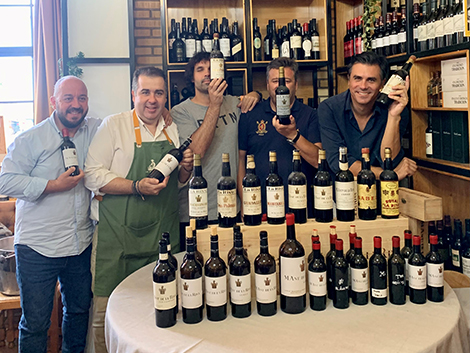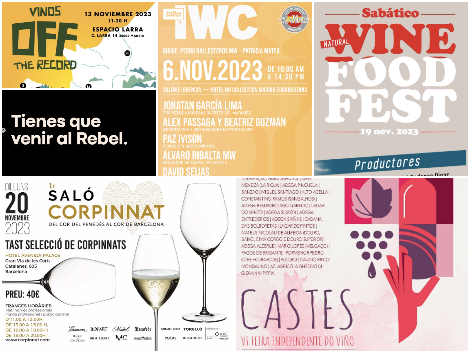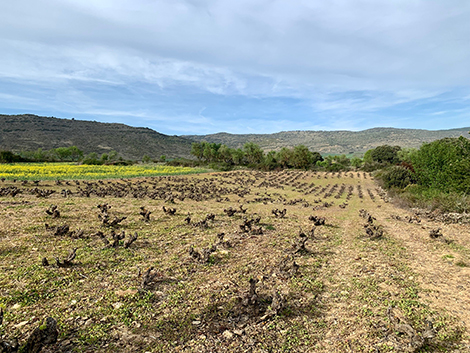De La Riva: treasuring sites and old wines in Sherry country

In a relatively short space of time, Willy Pérez and Ramiro Ibáñez have shaken up and revitalised Jerez with extraordinary energy. They have done this through research, understanding, a love of their land and a commitment to accurately reflect its terroir. Their words were as fascinating as their wines. Juancho Asenjo, a Spanish wine educator with a deep knowledge of the history of sherry, describes them as "the last generation of enlightened minds in Andalusia."
They met while studying oenology in Cádiz and went on to share experiences in Australia and California. A native of Jerez de la Frontera, Willy has always been around wine. He is the son of oenology professor Luis Pérez, a highly respected figure in the region who oversaw winemaking at the legendary bodega Pedro Domecq and founded his own winery in 2002, to which Willy has breathed new life. Ramiro Ibáñez is from Sanlúcar de Barrameda and has worked in Bordeaux. Working in a cooperative gave him access to a vast expanse of vineyards and the opportunity to ferment some of them separately. He has advised wineries such as Juan Piñero, helped local growers such as Callejuela and Mayetería Sanluqueña to develop their wine ranges and, in 2015, launched his own project, Cota 45.
Good friends since their university days, Willy and Ramiro share a curiosity about where they come from and a book about the history of the region and its terroirs, Los sobrinos de Haurie (Haurie's Nephews), which has been several years in the making. The title alludes to Jean Haurie, a winemaker and businessman who marked a turning point in the history of Sherry by liberalising its production and trade in 1778, after winning a lawsuit against the restrictions imposed by the vintners' guild. His legacy was carried on by his great-nephew Pedro Domecq Lembeye, who renamed the company after himself in 1822 and took it to the next level.
The two friends complement each other well: Willy concentrates on Jerez de la Frontera, inland, where fuller-bodied wines are produced; Ramiro works in the coastal area of Sanlúcar, where the vines produce more subtle and elegant wines. They see each other, as Willy puts it, as "brothers and partners in their personal exploration of Sherry wines."
Despite their own personal projects, Willy Pérez and Ramiro Ibáñez have found in De La Riva a place to delve deeper into the region's traditional wines and to connect with an increasingly passionate and knowledgeable community of sherry lovers.
The long road to De La Riva
De La Riva is one of the Sherry bodegas that has best preserved the connection between the wines and the vineyards. It was founded in the mid-19th century by Manuel Antonio de la Riva y Pomar (1838-1909), one of the many emigrants from Cantabria (northern Spain) who settled in Jerez. The basis of the business was a 1776 bodega, renowned for the quality of its old soleras, which Manuel Antonio bought from a relative. Although modest in size, it eventually comprised 53 hectares in Pago Macharnudo, including plots such as La Riva, Sabel and Los Arcos. His commitment to quality and his staunch defence of Sherry led him to become president of the Jerez Chamber of Commerce and to play an active role in politics as a member of the Spanish Parliament.
The estate remained in the hands of his descendants until it was acquired by Pedro Domecq in the early 1970s. Following the merger of Domecq and Allied-Lyons in 1994 and the subsequent disintegration of Allied-Domecq's assets after its acquisition by Pernod Ricard in 2005, the brand was shelved. Willy and Ramiro managed to buy the brand a few years later and started their project in 2017.
Willy's father saw the De La Riva soleras fading in Domecq's vast cellars, but he rescued the vineyard ledger, which contained valuable data about vine growing and winemaking practices since the 19th century. Flicking through its pages was one of the many pleasures of attending what must have been the most comprehensive De La Riva tasting ever.

The event was held at Las Esparteras, Toledo's wine-friendly restaurant on the motorway linking Madrid to Extremadura. It was organised by Raúl Álvarez, the driving force behind wine distributor Vinnac, who generously contributed a selection of old De La Riva bottles from his personal cellar.
Vino de pasto
De La Riva's portfolio is a mixture of limited, rare bottlings, the result of a bit of a treasure hunt (think of a Sherry version of Indiana Jones), and a few wines produced on a regular, annual basis. All in all, they reveal styles, terroirs, types and backgrounds that contribute to the understanding of Sherry, an extremely complex wine that has undergone many transformations over the centuries.
The house’s regular wines are the Vino de Pasto Macharnudo Alto, from the El Notario vineyard, the Vino de Pasto San Cayetano, also from Macharnudo - the first 2022 vintage was launched at the Place de Bordeaux last September and it was the first Spanish white ever to reach this market - and two Manzanillas: Fina and Pasada, from the Miraflores Baja and Balbaína Alta vineyards respectively.
The tasting began, however, with a wider selection of vinos de pasto. These are unfortified white wines with shorter ageing times - and therefore less influence from the flor - and are the first stage in expressing the terroir of the region. Although unable to bear the DO label unless they reach 15% abv, these wines were widespread in the past. "We cannot allow ourselves to lose the connection between white wines and finos and manzanillas," said Willy.
The winemaking process for De La Riva's vino de pasto may include a brief spell under the sun (asoleo), as in the case of San Cayetano 2022 (the toasted fruit notes certainly add complexity), although this depends on the vintage and the health of the grapes. Otherwise, they are fermented in casks and aged under a veil of yeasts for one or two years. Alcohol levels vary according to soil, vineyard location and exposure, ranging from 12.5% abv in coastal areas to the natural power of Macharnudo, further inland, where 14.5% abv can easily be reached.
Historical links play a key role in their search for terroirs. The Vino de Pasto Lacave 2021, just one butt produced, comes from a small vineyard to the north of Caserío de Lacave, in Sanlúcar's Maína vineyard, which belonged to the Terán family, owners of Lacave. It has creamy notes, with white fruit against a floral background, a hint of petrol and terrific acidity. According to Ramiro Ibáñez, it shows a "river" rather than oceanic influence and has "the spirit of an amontillado."
El Cuadrado Vino de Pasto Balbaína Alta 2021 also has a borderline character. It is located in Jerez de la Frontera, but it is an area traditionally farmed by mayetos (growers) from Sanlúcar, using their very own viticultural practices. Part of the Los Cuadrados sub-pago, Willy and Ramiro see it as a top vineyard, with very pure albariza soils and full of character. They have chosen the north-facing sector, which is cooler and has more organic content - a single butt has been produced. The nose opens with smoky and nutty notes, evolving into dried herbs and scented aromas, but the wine's defining element is its amazing texture and lingering finish. "Which vineyard better reflects Sanlúcar: Maína or Balbaína?," wondered Ramiro.

Macharnudo is much more powerful. Willy and Ramiro don't forget that this was the main source of supply for Pedro Domecq, "who was said to make the most potent white wine in Europe" and "established the canon for golden or oxidised wines, as opposed to the pale, biologically aged wines championed by Manuel María González Gordon of González Byass, who followed the Sanlúcar style of winemaking". Macharnudo was also the playground of the bodegas that continued to have a strong connection with the vineyards in the 20th century: Valdespino, the only one to carry this philosophy into the 21st century, and the two prestigious producers absorbed by Pedro Domecq: De La Riva itself and Agustín Blázquez.
Macharnudo Alto Vino de Pasto, of which only 1,500 to 2,000 bottles are made, shares this philosophy. The grapes come from the El Notario vineyard in the northern part of El Majuelo. In the 19th century, El Majuelo was the most prestigious Spanish vineyard in terms of the prices paid for its wines and its position on Europe's most important dinner tables*. It should be noted, however, that the style at that time was predominantly sweet, oxidative wines.
We were able to compare the first 2016 vintage, very well defined, extremely long and much to Ramiro's liking for its moderate weight and finesse, with the more powerful 2019, which shows the power and concentration expected of Macharnudo, but with a lovely juiciness and smoky notes that reminded me of Burgundy.
Under flor
None of the regular manzanillas in the range were available for tasting, so instead we tried some unique and sold-out gems. The Manzanilla Pasada Miraflores Alta comes from vineyards formerly owned by Rodríguez Lacave, which passed into the hands of various mayetos. One of them kept track of the source of the grapes to make a manzanilla until he sold the vineyard. Willy and Ramiro found four 125-litre butts that had not been topped up since 2008 and bottled the remaining wine en rama (unfiltered) in magnums. After 18 to 20 years of ageing, this old manzanilla, on its way to becoming an amontillado, offers a unique experience of concentration and depth, with a strong iodine and salty character. According to Ramiro, the Sanlúcar part of the duo, "this is the best vineyard in Miraflores" and the win
From the same provenance, the Amontillado Superiorísimo Miraflores Alta, which could be considered its older brother, has a markedly mature character. Sharp as a knife, it seems to be made of salt and concentration; certainly extreme and with remarkable intensity.
De La Riva's wines may definitely leave an unforgettable impression on those who have the chance to taste them, but the quantities produced are almost insignificant. Barely 30 litres of manzanilla and 40 litres of amontillado have been bottled from the previous wines. The most widely available wines from this pair of producers are the Manzanilla Fina Miraflores Alta (10,000 bottles) and the Vino de Pasto San Cayetano (6,000 bottles).
Oxidative styles
In the 19th century, before pale wines aged under flor became the standard of quality, Sherry's prestige was built on vintage Palo Cortado. Without flor, the elegance and ageing potential to develop into two (after 8 to 10 years of ageing), three (15 to 25 years) or four (from 35 to 65 years) cortados was directly linked, as Willy and Ramiro claim, to the best soils and vineyards. Contrary to Sanlúcar's specialisation in Palomino, a grape with a natural tendency to develop a veil of yeast, Jerez maintained a greater varietal diversity (including Perruno, Mantúo de Pilas or Mantúo Castellano) that favoured such a powerful style.

The three oxidative wines in the tasting had been aged for around 80 years, had alcohol levels of over 20% abv and came from very different sites in the region. We tasted the Veracruz Cuatro Cortados from Trebujena, an inland area at the northern tip of the DO with no influence from the sea and well suited to producing powerful wines. This is another example of butts found in a mayeto's cellar that had not been topped up for four decades. It tasted like a very old wine, with old furniture and brandy aromas, extremely concentrated and powerful with a spirit-like heat sensation.
El Álamo Cuatro Cortados, of which only 120 half-bottles have been made and which will be released this month, comes from the northern part of the Añina estate in Jerez, but from vines tended by a grower from Sanlúcar de Barrameda. It is creamier and gentler, with hints of dark chocolate, toffee and burnt sugar. On the palate, it also shows a lot of concentration, but it feels fresher, much more elegant and with an extremely long finish.
The third site is Balbaína Baja. The wine is Oloroso Viejísimo from the Fabuloso solera, the most iconic wine of the now defunct Cuvillo & Cía. in El Puerto de Santa María. It used to be topped up with wines from El Limbo and Santa Ana vineyards. With the crisis of the 1980s, the winery was forced to give this wine as payment to a Jerez architect, who kept it in the family house without topping it up for almost 40 years. Of the 12 butts in the solera, which had shrunk by half, Willy and Ramiro selected the finest and most balanced to fill 1,300 half bottles. The wine smelled of bitter orange jam, sweet spices and a touch of volatile acidity that added freshness; very sharp, long on the palate, finishing with notes of pistachio.
Sweet styles
The tasting also featured two classic sweet wines: a Moscatel and a Tintilla de Rota, both from sandy soils. De la Riva Moscatel Viejísmo Loma Baja comes from Chipiona, a traditional growing area for this variety. It is the solera of the family's Pico Plata Reserva, produced by Florido Hermanos, another bodega bought by Pedro Domecq in the 1970s. Like many of the previous wines, the few butts that remained in the family's hands were left untouched for a long time, so only 50 litres were recovered to fill 120 half bottles. At 15% alcohol and 420 g of sugar, this was an unfortified wine made from sun-dried grapes. The character of the variety is well defined, with notes of aniseed, raisins, sweet spices and candied fruit. On the palate, it showed remarkable freshness, a beautiful texture and length.
The Tintilla de Rota, with over 400 g of sugar and a deeper colour than the previous one, seemed younger, with generous notes of caramel and white chocolate and a round texture on the palate thanks to the generous amount of sugar. Both wines remain quite firm and lively for their age.
Old bottles
The treat of the day was the old bottles shared by Raúl Álvarez, all from the period before Pedro Domecq bought De La Riva.
The wines were generally in very good condition, except for the Fino Macharnudo from the early 1970s, which showed clear signs of oxidation, and the Fino Amontillado, which was probably the oldest wine, as Alvarez dated it to the 1950s.
The Tres Palmas was much more serious, creamy, not particularly rich, but with complex petrol notes and a very long finish. The Amontillado Superior Guadalupe seemed older, with well-defined notes of pistachio on the finish, but retained its character and depth, with the enveloping texture that sherry develops after several years in bottle. The Manzanilla also showed a good balance between the ageing notes and the smooth texture, together with a long finish.

Dating from the 1960s and bearing the stylish labels that Willy and Ramiro have reproduced for their wines, we tasted a salty, round Amontillado Reserva, with hints of tar and low tide over a toasted background, and a slightly sweet Oloroso Reserva, also highly concentrated, with petrol, old furniture and nutty notes; a real meditation wine. Viña Sabel, at 18% abv, came from the plot of the same name in Macharnudo. The vineyard has a high concentration of limestone and is located next to San Cayetano; apparently it had a certain amount of Pedro Ximenez at the time and was used to make sweet wines. It is reminiscent of an amontillado on the nose, but the sweet touch on the palate rounds off any edges and adds beautiful balance.

It is not easy to assimilate the variety and intensity of flavours experienced during the tasting, or the wealth of information accompanying each wine. The underlying message was the complexity and the many different expressions of a wine that has developed a changing identity over the centuries. There is no doubt that the eloquent voices of Willy Pérez and Ramiro Ibáñez, who always seem to be a few steps ahead, are a driving force for the region. I would like to highlight a sentence from the brochure they handed out to those of us who attended the tasting: "A wine that shows its identity becomes immortal, that's why it can't be reduced to a specific zone or a specific ageing technique". It is a question of transcendence.
* Madoz's Dictionary from 1830 contains a detailed description of El Majuelo, noting that it employed "200 workers who were kept busy" and produced "1,500 butts of 30 arrobas each [about 500 litres]". He added: "The cellars contain up to 15,000 pipes of all kinds of wine, some of which are 100 years old." A year later, James Busby, the father of Australian wine, wrote that the Don Pedro vineyard consisted entirely of limestone knolls and that it was evident that the vines were treated with far greater care than any other he had seen.
Furthermore, during a period of relatively low sherry prices in the 19th century, Pedro Domecq's Macharnudo (pictured below) fetched the same price as Tokaj and the most expensive Sauternes. Later, the gap widened in favour of sherry.


Amaya Cervera
A wine journalist with almost 30 years' experience, she is the founder of the award-winning Spanish Wine Lover website. In 2023, she won the National Gastronomy Award for Gastronomic Communication
The Garnacha landscapes of Navarra
NEWSLETTER
Join our community of Spanish wine lovers






